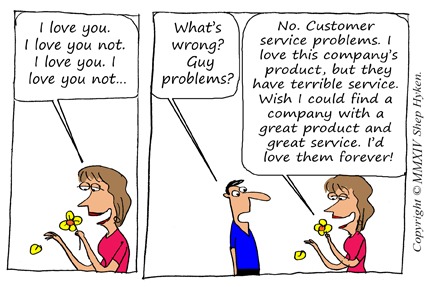However you measure customer service, making improvements is never simple.
Organizations who have moved from good to great and are delivering world class service have done so by implementing root-and-branch change of how they interact with customers.
Indeed, you could say that they’ve gone from customer service to customer care.
The two concepts are worlds apart. It’s one thing to serve customers, but it’s quite another to actually care for them.
We traditionally associate care with health, and the parallels are not wholly out of place. You can provide good service with healthcare, but that only implies the basics – welcoming, reacting, etc. When you care, you’re proactive, and you listen to the needs of the customer (or patient), or better – provide what your customer needs before they say they need it.
Customer care begins with learning to listen to customers
How well do you actually listen? John Cronin pointed out that listening isn’t as simple as we at first thought. In fact, when many people say they’re listening, they’re not – they’re ready to jump in to a conversation with their own arguments and points of view, irrespective of what has been said.
Effective communication is as much about good listening as good articulation.
So, learn to listen to your customers better. Don’t be ready with a standard chunk of pre-learned text, don’t be ready with flow-charts that dictate a conversation – actually have a conversation, and make it a two-way communication where you are listening in the customer’s context, not yours.
Secondly, learning to listen doesn’t always have to be in a conversation. Social listening is the Next. Big. Thing, at least according to the software industry, with large and small organizations investing heavily in ways to listen in to social conversations.
Look at Microsoft’s sudden investment in a field it had so willingly avoided for so long – partly in an attempt to catch up with Salesforce, but also because customer service and marketing teams have been floundering with the disintegration of customer interaction points.
When you show customer care, you’re proactive, you listen and understand customers, then deliver on needs before they even ask for it.
Listening socially means knowing where to look in the first instance, but it also involves human interpretation. You can automate all you like, but sentiment monitoring and scoring cannot always be done by computer.
Growing your customer knowledge
This social listening feeds into a wider view of the customer. We know contact details, purchase & product details, and we even log our one-to-one conversations, but are we logging sentiment? Are we logging those social conversations to which we are not even party?
Right at the heart of customer care is a technological issue that can only be solved by people. That sounds like a conundrum, but the answer is not technology – it’s how you use it.
First consider what knowledge would improve your customer care. What nuggets of information could move you up a level in customers’ eyes? Then decide how you’re going to pull that knowledge in to one central location (CRM, database, whatever) and how you’re going to interpret & use that knowledge.
If a prized customer has been talking to a friend on Twitter about how slow you are to respond, this isn’t an opportunity to jump in and dominate the conversation. It’s an opportunity to log that information against the customer, and ensure that all stakeholders in customer interactions know about it. Therefore, sentiment isn’t too good, and the customer needs quicker responses.
Growing your knowledge cannot happen without a method of centralizing and utilizing that knowledge.
Growing a culture of customer care
We can get hung up on metrics – customer retention, reaction times, NPS scores… but it’s only when we get everyone’s buy-in that these metrics actually make any sense. For a lot of people, they’ll just be figures that ‘management’ have imposed.
A greater understanding of why these metrics are being measured contributes massively to their value.
From there, a greater appreciation of how customer care has made a difference to the business can help ingrain more customer-focused attitudes into the workplace. For instance, celebrating great examples of how customer issues have been turned around, or better – celebrating great examples of how customer knowledge have been turned into customer success – can really enthuse people and get everyone thinking about how to ‘care’ for customers rather than just ‘serve’ them.
Encourage, enhance, then engage with customers
By firstly encouraging people – and then by giving them the resources and tools to proactively care for customers – you can develop a culture that puts customer care at its heart.
These, for me, are the three key elements of moving from customer service to customer care: learning to listen, interpreting your findings, and developing a culture of customer care. Those foundations – of learning, listening and interpreting – should flow naturally through an organisation. If everyone is bought in to the idea, if everyone sees what they’re getting out of it, everyone does better.
